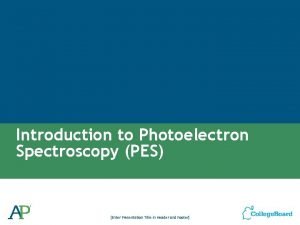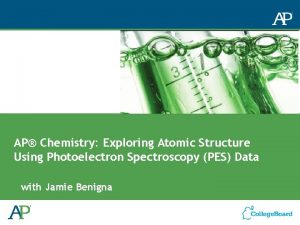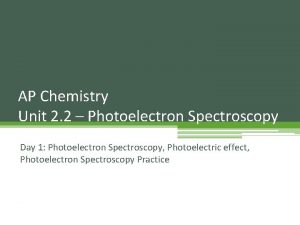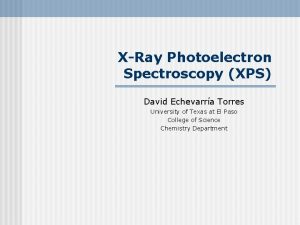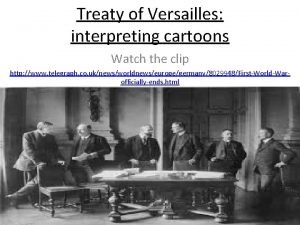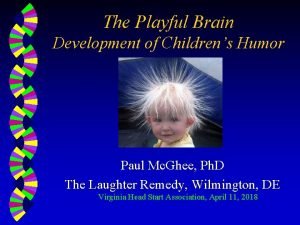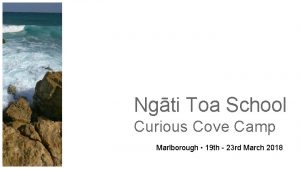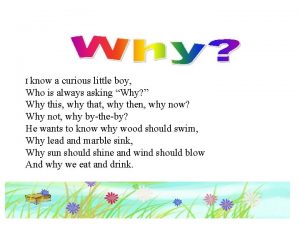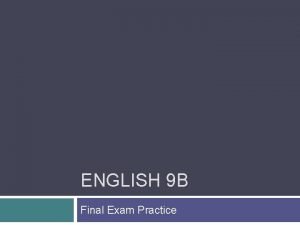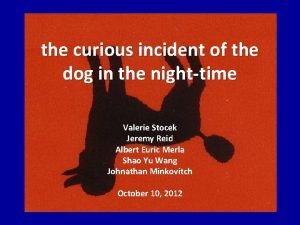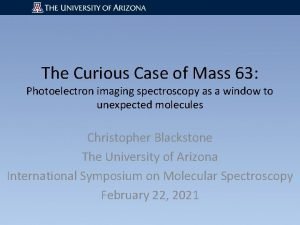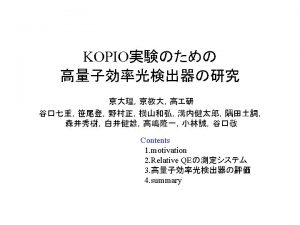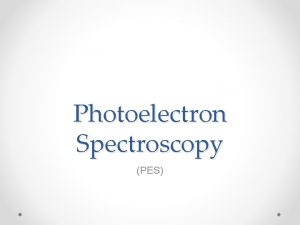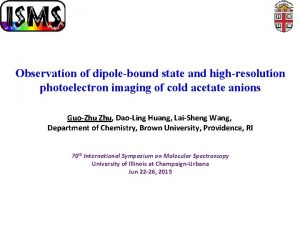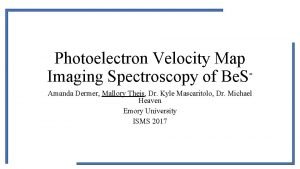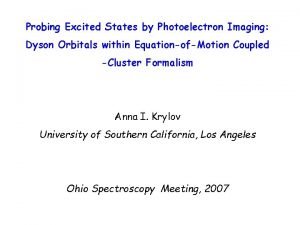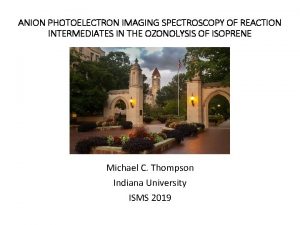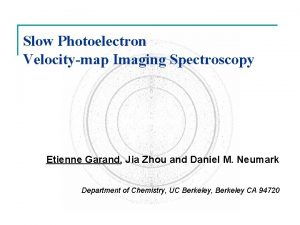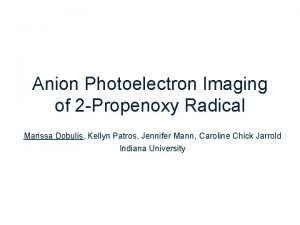The Curious Case of Mass 63 Photoelectron imaging















- Slides: 15

The Curious Case of Mass 63: Photoelectron imaging spectroscopy as a window to unexpected molecules Christopher Blackstone The University of Arizona International Symposium on Molecular Spectroscopy December 17, 2021

Ozone Chemistry • A source of interesting radicals and ions HO 2− HOMO 0 -0, 1 0 1 2 3 -0, 2 5 v 0 v 1 -0, 3 β 4 -0, 4 v 2 -0, 5 v 3 -0, 6 v 4 -0, 7 v 5 -0, 8 v 6 -0, 9 -1 pd e. KE/e. V E. P. Clifford, P. G. Wenthold, R Gareyev, W. C. Lineberger, C. H. De. Puy, V. M. Bierbaum, and G. B. Ellison, J. Chem. Phys. , 109, 10293 (1998)

Ozone Chemistry • A source of interesting radicals and ions

Ozone Chemistry • A source of interesting radicals and ions Josep M. Anglada, Miquel Torrent-Sucarrat, Manuel F. Ruiz-Lopez, and Marilia Martins-Costa, Chem. Eur. J. , 18, 13435 (2012)

Photoelectron Imaging Spectroscopy Electron Kinetic Energy (e. KE) Electron Binding Energy (e. BE) hν Neutral X e. KE e. BE kinetic energy of photoelectrons binding energy of electrons e. KE = hν - e. BE photon energy Anion X- X- + hv → X* + e-(e. KE)

Photoelectron Spectrometer CCD Camera Pulsed nozzle (GV Series 9) ε Raw Abel Potential switch Deflectors Accel. Stack Electron gun (~1 ke. V) (~2 k. V) Source Chamber Dual MCP, phosphor screen Einzel lens TOF Mass Spectrometer laser beam ε Photoelectron imaging assembly

The Photoelectron Image θ r v e. BE = hν - e. KE ε O− 355 nm 50 θ 100 150

Ion Generation Pulsed nozzle e- X e- (<1 ke. V) H 2 O G X Z G H 2 O G X X G H 2 O X = CH 3 OH G = O 2 CH 3 OH + O‾ → CH 3 O‾ + OH CH 3 O‾ + O 2 → CH 2 O + HO 2‾ Electron gun (~1 ke. V) X – precursor G – carrier gas (Ar, N 2 O, O 2, CO 2, etc. ) Z – Impurities - Secondary electron attachment (Cluster dissociation) X + e‾ → X- Dissociative attachment N 2 O - → N 2 + O - Deprotonation reactions O- + CH 4 → CH 3 - + OH → CH 2 - + H 2 O - Water and carrier gas cluster formation X-(H 2 O)n or X-(G)n

Mass Spectrum O 2 ‾ CH 3 O‾ 30 HO 2‾ 35 O 4 ‾ CH 3 O 3‾ HO ‾ 4 HO 3‾ 40 45 50 m/z (amu) 55 60 65

Photoelectron Image/Spectrum 0 CH 3 O 3‾ 355 nm Structure EA/e. V (calc. ) 1. 94 (B 3 LYP/6 -311++G**) 0, 5 1 1, 5 2 e. BE/e. V EA/e. V (exp. ) 2, 5 3 3, 5 VDE/e. V (calc. ) <2 (estimated) 1. 06 (CCSD/aug-cc-p. VDZ) 4. 08 (B 3 LYP/aug-cc-p. VDZ) ~4 (estimated) 1. 18 (CCSD/aug-cc-p. VDZ) 2. 75 (CCSD/aug-cc-p. VDZ) 3. 43 (EOM-IP-CCSD(T)/ aug-cc-p. VTZ)

Franck-Condon Simulation Second electronic state VDE = 3. 54 e. V v (m/s)

What is it? • Anion almost entirely absent from literature – One instance of it being coordinated to titanium as an intermediate in a reaction S. Tang, N. Rijs, J. Li, M. Schlangen, H. Schwarz, Chem. Eur. J. 21, 1 (2015)

Ion Generation Pulsed nozzle e- X e- (<1 ke. V) H 2 O G X Z G H 2 O G X X G H 2 O X = CH 3 OH G = O 2 CH 3 OH + O‾ → CH 3 O‾ + OH CH 3 O‾ + O 2 → CH 2 O + HO 2‾ CH 3 O‾ + O 2 → CH 3 O 3‾ A competing reaction? Electron gun (~1 ke. V) X – precursor G – carrier gas (Ar, N 2 O, O 2, CO 2, etc. ) Z – Impurities - Secondary electron attachment X + e‾ → X- Dissociative attachment N 2 O - → N 2 + O - Deprotonation reactions O- + CH 4 → CH 3 - + OH → CH 2 - + H 2 O - Water and carrier gas cluster formation X-(H 2 O)n or X-(G)n

Summary and Future Directions • CH 3 O 3‾ Summary – Imaged mass peak 63 amu and determined structure • Comparison to ab initio calculations and previous experimental work • CH 3 O 3‾ Future Directions – Collect spectrum at higher photon energy • Assign electronic states and confirm structure completely – Determine the molecule’s context • How are we generating it in our system? • Could it be relevant in atmospheric chemistry? • Other Projects – Adduct species, HO 3‾, HO 4‾, HO 5‾ • Appear in mass spectrum, need photoelectron images

Group: Acknowledgements Chris Blackstone Yerbolat Dauletyarov Adam Wallace Dr. Dmitry Khuseynov (Exxon-Mobil) Dr. Lori Marie Culberson (Bruker) Dr. Emily Rose Grumbling (NSF) Prof. Daniel Goebbert (U of Alabama) Dr. Kostya Pichugin (MPI, Hamburg) Prof. Terefe Habteyes (U. of New Mexico) Prof. Luis Velarde (SUNY, Buffalo) Prof. F. Ahu Akin (Bogazici Univ. ) Matt Fontana (UCLA) Daniel Dokuchitz Dominique Villela (UA) Prof. Richard Mabbs (Washington Univ. ) Laura Schirra (REU UA) Dr. Eric Surber (Esterline Defense Techn. ) POTENTIAL ENERGY (Chris) Tian Xue (UC Berkeley) Dr. Andrew Dixon (Silberline Manufacturing, LLC) Sanov group in a time-dependent superposition of excited states Special thanks to: Image processing/Abel Inversion/BASEX: Hanna Reisler (USC) Theory advice: Anna Krylov (USC) Department Resources: Kevin Bao (CHIEF) GROUND STATE Funding: National Science Foundation Arizona TRIF Imaging and Photonics Programs
 Frc driver station mac
Frc driver station mac Themes in benjamin button
Themes in benjamin button The curious case of the carbon copy kitty
The curious case of the carbon copy kitty Photoelectron spectroscopy
Photoelectron spectroscopy Photoelectron spectroscopy pogil
Photoelectron spectroscopy pogil Photoelectron spectroscopy ap chemistry
Photoelectron spectroscopy ap chemistry Xps instrument
Xps instrument Best case worst case average case
Best case worst case average case At the peace table political cartoon
At the peace table political cartoon Curious george smoking a pipe
Curious george smoking a pipe The curious savage quotes
The curious savage quotes Curious cove
Curious cove I know a curious little boy
I know a curious little boy English 9 final exam
English 9 final exam The curious incident of the dog in the nighttime genre
The curious incident of the dog in the nighttime genre Curious george gets a talker
Curious george gets a talker



